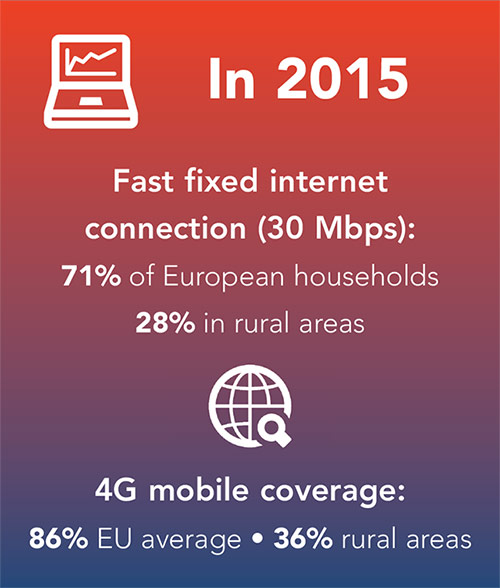Advancing the Digital Single Market

The European Commission has advanced its strategy for a Digital Single Market (DSM) through detailed plans to improve connectivity and modernise copyright. The plans were revealed in Bratislava in September during a meeting between Europe’s leaders.
A move toward a Digital Single Market, first introduced in May 2015, has been a long-term priority for the European Commission and its direction has been set out by three key pillars. Recognition of the need for greater flexibility across digital borders and less regulation has been supported with targeted actions:
1) better access for consumers and businesses to digital goods and services across Europe;
2) creating the right conditions and a level playing field for digital networks and innovative services to flourish; and
3) maximising the growth potential of the digital economy.
President of the European Commission, Jean-Claude Juncker’s announcement in Bratislava in September marked the next stage, and most ambitious aspect, of DSM creation. The initiatives are tailored to meet Europe’s growing connectivity needs and boost competitiveness, creating an encouraging market for private investment, while overhauling the existing EU telecoms rules.
In preparing for Europe’s digital future, the Commission has identified three strategic connectivity objectives for 2025. These include:
• Access to extremely high gigabit connectivity to all main socio-economic drivers such as education and research facilities, transports hubs, public service provider buildings and digital technology driven enterprises. The target set is for users to have download and upload speed of one gigabit of data per second;
• All households across Europe, both urban and rural, to access to a download speed of 100 Mbps, which can be upgraded to Gbps;
• Uninterrupted 5G coverage to all urban areas, including major roads and railways. An interim target of 5G being commercially available in at least one major city in each EU member state by 2020.
Recognising the need for large scale investment to make the targets achievable the Commission has proposed a new European Electronic Communications Code, which it claims includes “forward-looking and simplified rules that make it more attractive for all companies to invest in new top-quality infrastructures”. It also estimates that investment triggered by the new framework could boost GDP by an additional €910 billion and create 1.3 million new jobs by 2025.
It is estimated that the cost of achieving the new objectives could total €500 billion, largely from private sources. However, analysis of current investment trends means the likelihood of a €155 billion shortfall. Aiming to address the shortfall, the Commission has proposed a modernisation of EU telecoms rules (last updated in 2009), in a bid to stimulate competition and drive investment. The benefits of which include a strengthening of the internal market and of consumer rights.
“We need to be connected. Our economy needs it. People need it. And we have to invest in that connectivity now.”Jean-Claude Juncker
The new European Communications Code proposes:
Increased competition and predictability for Investments. A stable regulatory environment which reduces divergences between regulatory practices across Europe and a reduction of regulation allowing for co-investment by rival operators. The reduction is also aimed at encouraging small and new investors in less profitable areas such as rural locations.
Better use of radio frequencies. Long license durations coupled with tighter restrictions to use spectrum effectively and efficiently. It also proposes to coordinate basic parameters such as the timing of assignments to ensure timely release of spectrum to the EU market and more converged spectrum policies across the EU with the aim to provide full wireless coverage across the EU.
Stronger consumer protection. Making it easier to switch suppliers when consumers are signed up to bundles and ensuring vulnerable groups can access affordable internet contracts.
A safer online environment for users and fairer rules for all players. Extension of selected rules aimed at securing networks and servers to new providers and the potential creation of an EU emergency number at no additional costs.

A further proposal announced a free Wi-Fi scheme with an initial budget of €120 million for local authorities to implement Wi-Fi for public spaces. While the presentation of a 5G action plan included a common EU calendar for a coordinated 5G commercial launch in 2020, a joined up approach to spectrum use, pan-European 5G trials as of 2018 and potential provision of venture capital for start-ups developing 5G solutions.
Andrus Ansip, Vice-President for the Digital Single Market, says: “Without first-class communication networks, there will be no Digital Single Market. We need connectivity that people can afford and use while on the move. To achieve that, spectrum policies must be better coordinated across the EU. More competition and further integration of the European market will allow us to reach these goals, helped by the right environment created by the new Communications Code.”
EU copyright
A second element of the DSM announcement in Bratislava circulated EU copyright rules and a need for modernisation to align with changes to digital technology. The three proposals adopted by the Commission include:
- better choice and access to content online and across borders;
- improved copyright rules on education, research, cultural heritage and inclusion of disabled people; and
- a fairer and sustainable marketplace for creators, the creative industries and the press.
Günther H. Oettinger, Commissioner for the Digital Economy and Society, adds: “Our creative industries will benefit from these reforms which tackle the challenges of the digital age successfully while offering European consumers a wider choice of content to enjoy. We are proposing a copyright environment that is stimulating, fair and rewards investment.”





